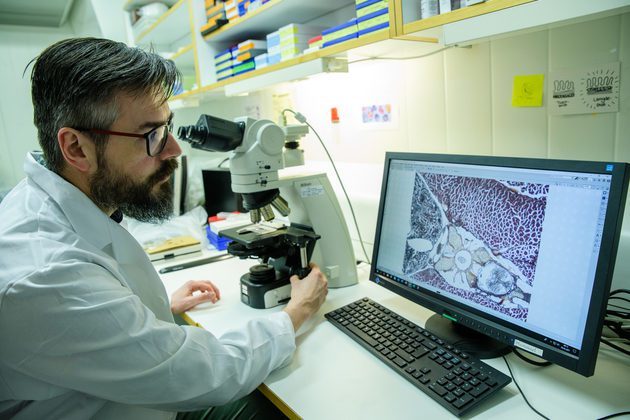Larval stage stress can make farmed fish more robust later in life

Can fish be programmed to be robust? Scientists are working on establishing a method that can make fish more tolerant to various stresses.
Conclusions:
- The study confirms that treatment with low levels of oxygen during the early life phase can trigger an epigenetic response in salmon.
- Whether this has the potential to improve tolerance to hypoxia – oxygen deficiency – and the effect of such treatments on the fish’s response to other environmental stressors, overall survival and other side effects must be investigated more thoroughly.
Many methods are used to ensure that farmed salmon thrive, stay healthy and grow quickly. Nofima scientist Erik Burgerhout is working on programming the fish to become robust.
Fish welfare and profitability
No, this isn’t science fiction. It is about epigenetics. The Programming Fish for Robustness (Progress) research project exposes fish to stressors such as low temperatures and low oxygen levels in early life phases, thereby influencing them to develop their own genetic material – RNA – to better withstand stress later in life.
“In order to produce a robust farmed fish, we must return to nature. Cold temperatures are natural for wild salmon, so it is actually the relatively high temperature normal to fish farming that is the stressful factor. We are now conducting research to understand what lies behind these mechanisms”, says Erik Burgerhout.
Within the field of genetics, phenotype refers to the observable physical properties of an organism, i.e. the properties expressed in an organism. Phenotype contrasts with genotype, which is the information contained in the genes (DNA) of an individual or cell. Stress can affect the phenotype of the fish, through changes in epigenetics and transcriptomics, which change protein production.
Phenotype changes can be beneficial for the fish and enable them to withstand future stressors.
“We have noticed that low oxygen levels – hypoxia – affect the fish. The question is whether low oxygen levels during the early life phase would program the fish to withstand little oxygen in later life, as well as improve the fish’s immune system”, says Erik Burgerhout.
Increase understanding
Fish welfare and profitability are important keywords in the development of the aquaculture industry. The aim is for farmed fish to have a good immune system, be able to cope with disease and to grow fast. In other words, that they thrive and are robust throughout the various phases of life. According to the online portal called Sustainability in Aquaculture, 15 to 20 percent of the total number, and 6 to 9 percent of the total weight of salmon and trout farmed at sea have been lost in recent years. So, healthy fish in all phases of life is equal to good profitability.
The Progress research project was therefore established as a strategic institute project to increase the Nofima scientists’ understanding of how epigenetic programming can contribute to creating a robust farmed salmon. Epigenetics is a branch of study within the field of biology that focuses on hereditary traits that are not caused by alterations in the DNA sequence itself, but are caused by how the DNA sequence is read and used (see more information about epigenetics in the fact box)
In the project, Nofima has collaborated with the Arctic University of Norway (UiT) and the University of Melbourne in Australia.
Stress
Stress during early life phases can have a serious impact on the development, growth and behaviour of various animal groups, including fish. However, there is currently little knowledge about the epigenetic regulation mechanisms involved – i.e., in this case, whether the impact of stress causes the fish to develop their own robustness throughout the rest of their lives, and the level of stress that is justifiable from an animal welfare perspective.
In the Progress project, salmon were exposed to low oxygen levels during the embryonic/larval stage. Later, the same fish were investigated regarding their survival in the seawater phase, growth and disease resistance. According to Burgerhout, the results did not quite meet expectations.
“We measured the fish’s tolerance to low oxygen levels, and investigated the development of its immune genes during smoltification. In addition, we investigated the immune response after exposing the fish to pathogenic bacteria that are feared in the aquaculture industry. We only managed to see small differences between fish that were exposed to stress with little oxygen early in life and fish that had not had this type of impact. We don’t consider these negative results, but rather results without the expected impact. More studies are needed before we can say anything for sure”, says Erik Burgerhout.
“Although we found little difference between the groups regarding the hypoxia challenge test, the results suggest that chronic hypoxia during the early phase of life stimulated immune genes and dampened their downregulation in connection with smoltification. However, these changes did not improve protection against a bacterial pathogen”, he stated.
The project results show the potential for environmental stimuli to be used as treatments to shape gene regulation in farmed salmon.
Burgerhout points out that the fish in another project, Aquagenom, were tested for impacts using different temperatures.
“We see greater differences in that project. Therefore, we can say more about what works well and what doesn’t work as well. Both are important and correct to share, so that others can utilise the knowledge”, says Erik Burgerhout.
Tremendous pace
The Nofima scientist has a background and a PhD in physiology, and has a great interest in all aspects that may affect the development of farmed fish. Why does a fish grow quickly? Why does one fish respond differently to another when exposed to environmental changes?
“Most interesting is the understanding of the underlying mechanisms regarding how and why a fish reacts to an environment. And of course also how we can use this information to improve fish welfare and fish health in order to make aquaculture more sustainable”, says the Nofima scientist.
Temperature, oxygen level and access to food are among the parameters that affect the development of farmed fish. As they grow, the fish have less energy available to use for other processes. What does that mean? “The main point is that fish cannot grow all the time. Fighting disease and smoltification, for example, come in addition to this. If you stretch the elastic band too far in one direction, it will break. You have to weigh up everything you do in fish farming”, Burgerhout states.
“As scientists, we are in constant need of a better understanding of what is happening inside the fish. And an understanding of which methods can improve welfare and profitability. When we know which genes are activated to cope with low levels of oxygen, for example, we might be able to do something to make the fish more robust in later stages of life”, says Burgerhout, adding:
The focus is often on rapid production – selection for rapid growth, high temperature, large smolt – but the main point is that a fish cannot – and most likely should not – spend ‘all’ of its energy on growth, especially during the early phases of life.
Facts about epigenetics
Epigenetics is the study of how DNA is read and expressed. An epigenetic property is a stable inherited phenotype that is not caused by alterations in the DNA sequence.
An example of an epigenetic alteration is the differentiation of different cell types in tissues and organs when multicellular organisms develop. Impacts from the environment can lead to epigenetic alterations.
The genes contain information about the properties an organism can potentially have, but epigenetic mechanisms control whether the properties are expressed or not.
Epigenetics is also a link between heredity and the environment, because at the molecular level it explains how impacts from the environment can alter the expression of most genes. At birth, an organism is a product of the genes and the environmental impacts it inherits from its parents. In addition, epigenetic modifications accumulated by the organism throughout its lifetime can affect how it becomes, the diseases it gets and how it ages.
The sum of all epigenetic modifications on the chromosomes is called the epigenome. An organism has one genome, but many epigenomes, which vary from cell type to cell type.
Source: Great Norwegian Encyclopedia and Wikipedia
Facts about the research
Progress is a strategic institute initiative (SIS) in Nofima, and financed with internal funds.
Contact person
Projects
